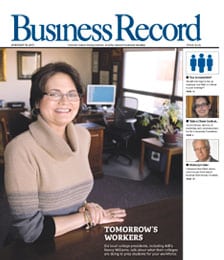Interesting stocks in the ‘boring’ insurance field

Dear Mr. Berko:
What do you think of the property and casualty business over the next few years? If your response is favorable, would you recommend a couple of lesser-known companies rather than Safeco, Progressive and Travelers, which everybody knows and owns?
G.A., Springfield, Ill.
Dear G.A.:
This is a boring industry. Its accounting is so arcane that only actuaries, statisticians, warlocks and mushroom farmers understand it. And I have a deep, visceral hostility for this industry because insurers and their deep pockets are one of the principal reasons for the high costs of many products and services.
That said, I think the property and casualty, or P/C, business will continue to benefit strongly from excellent fundamentals. The last couple of years were nicely profitable for most carriers, and it appears that the coming two to three years may be even better.
The Twin Towers tragedy sparked and gave impetus to needed premium increases in almost all product lines. Rate increases were painfully solid in officers’ and directors’ liability insurance (thanks to Ken Lay and the Fastows at Enron, John Rigas and sons at Adelphia Communications, Bernie Ebbers and friends at MCI, Dennis Kozlowski and buddies at Tyco International, ad nauseam), allowing the P/C companies to enjoy almost unlimited pricing power.
Rate increases were impressively strong in the aviation, real estate, cruise ships, marine and hotel sectors. Higher interest rates (P/Cs generally keep 80 percent of their portfolios in fixed-income securities) should improve investment returns for many insurers. Meanwhile, many insurers have successfully reduced their operating costs. So, combined with lower loss ratios, the next few years could be compellingly profitable for this sector.
The “X” factor, of course, is potential terrorist activity. Still, most P/Cs booked record earnings last year and (barring another bloodbath in the United States) should continue to post record earnings for the next few years. The following two issues may offer potential for some beddable long-term gains in your portfolio.
HCC Insurance Holdings Inc. (HCC-$30.26) has grown by bounds, vaults and leaps over the past 10 years via acquisitions. Premiums in 1994 were a measly $46 million and last year HCC reported premium income of $738 million with earnings of $2.25 a share. This year HCC expects to report premium income of $960 million with earnings of $2.75. According to Standard & Poor’s, HCC should have $1.2 billion in premium income and earn between $3.15 and $3.20 a share in 2005. These numbers reflect expected strong gains in its aviation, errors-and-omissions, officers’ liability and diversified financial products segments. They also reflect management’s extremely stringent underwriting requirements, lower operating costs and a stable loss ratio.
HCC has a good balance sheet, a strong reserve account and a book value exceeding $18.50, but pays a cheesy dividend of 30 cents.
HCC trades at a low nine to 10 times next year’s earnings. However, its average price-earnings ratio during the last decade has ranged between a low of 12.6 and a high of 24.9 for an average P/E of 16.2 over that time frame. So, giving that average P/E a haircut down to 14.5 and assuming HCC will earn $3.15 a share, it’s not unreasonable to place a 12-month share price at $45.
I also think that Montpelier Re Holdings Ltd., which went public at $20 a share in 2002 with revenues of $379 million and earnings of $2.74 a share, is compelling. Montpelier (MRH-$36.98) is a global P/C insurer, and only 47 percent of its 2003 revenues of $810 million derived from the United States and Canada. MRH writes property catastrophe insurance, which is protection against loss from earthquakes, hurricanes, floods, tornadoes, tsunamis and other natural disasters. MRH also writes “retrocessional” coverage, which provides catastrophe protection for the portfolios of other insurers. MRH’s third insurance category is called property specialty, which provides the insured with reinsurance protection beyond a specified limit set in the contract. Finally, MRH sells aviation liability, aviation war, marine, personal accident catastrophe, workers’ compensation and terrorism policies. These contracts exclude coverage from nuclear, biological and chemical attacks.
MRH expects to earn $5.05 a share this year, thanks to excellent management, superb property risk models and a sterling reputation for a well-written, quality product. Its underwriting has tight oversight and frequent peer review, and its profits have been superb. Its balance sheet has no legacy problems (policies written prior to 2001), its cash position is strong, its reserve account is heavily fortified and its tangible book value is $29 a share.
MRH trades at seven times 2004 earnings, which is embarrassingly low. I reckon HRH ought to trade between nine and 11 times earnings. This is still embarrassingly low, especially considering the fact that MRH is highly regarded among its peers. With share earnings expected to be $5.05 this year and possibly $5.85 in 2005, I think MRH should be a $50 stock.
Please address your financial questions to Malcolm Berko, P.O. Box 1416, Boca Raton, Fla. 33429 or e-mail him at malber@adelphia.net.







